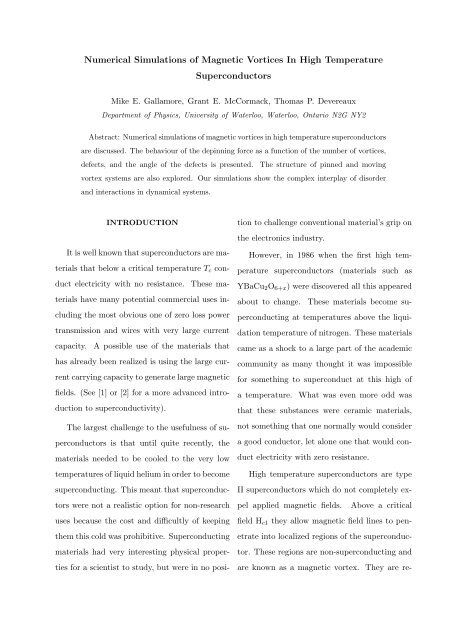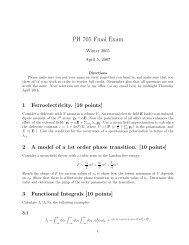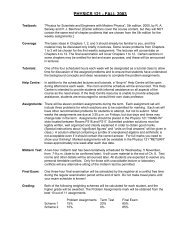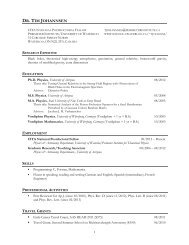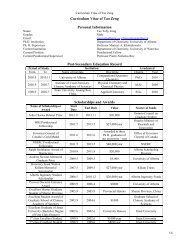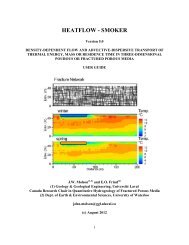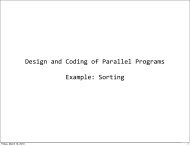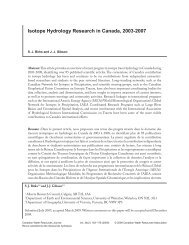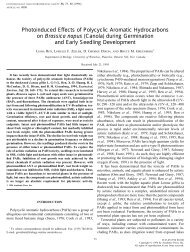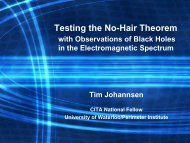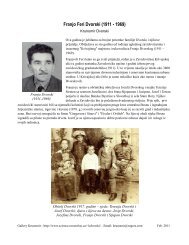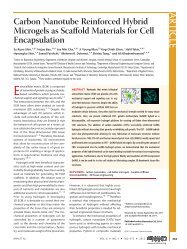Undergraduate paper on numerical simulations of vortices.
Undergraduate paper on numerical simulations of vortices.
Undergraduate paper on numerical simulations of vortices.
Create successful ePaper yourself
Turn your PDF publications into a flip-book with our unique Google optimized e-Paper software.
Numerical Simulati<strong>on</strong>s <strong>of</strong> Magnetic Vortices In High Temperature<br />
Superc<strong>on</strong>ductors<br />
Mike E. Gallamore, Grant E. McCormack, Thomas P. Devereaux<br />
Department <strong>of</strong> Physics, University <strong>of</strong> Waterloo, Waterloo, Ontario N2G NY2<br />
Abstract: Numerical simulati<strong>on</strong>s <strong>of</strong> magnetic <strong>vortices</strong> in high temperature superc<strong>on</strong>ductors<br />
are discussed. The behaviour <strong>of</strong> the depinning force as a functi<strong>on</strong> <strong>of</strong> the number <strong>of</strong> <strong>vortices</strong>,<br />
defects, and the angle <strong>of</strong> the defects is presented. The structure <strong>of</strong> pinned and moving<br />
vortex systems are also explored. Our simulati<strong>on</strong>s show the complex interplay <strong>of</strong> disorder<br />
and interacti<strong>on</strong>s in dynamical systems.<br />
INTRODUCTION<br />
It is well known that superc<strong>on</strong>ductors are materials<br />
that below a critical temperature T c c<strong>on</strong>duct<br />
electricity with no resistance. These materials<br />
have many potential commercial uses including<br />
the most obvious <strong>on</strong>e <strong>of</strong> zero loss power<br />
transmissi<strong>on</strong> and wires with very large current<br />
capacity. A possible use <strong>of</strong> the materials that<br />
has already been realized is using the large current<br />
carrying capacity to generate large magnetic<br />
fields. (See [1] or [2] for a more advanced introducti<strong>on</strong><br />
to superc<strong>on</strong>ductivity).<br />
The largest challenge to the usefulness <strong>of</strong> superc<strong>on</strong>ductors<br />
is that until quite recently, the<br />
materials needed to be cooled to the very low<br />
temperatures <strong>of</strong> liquid helium in order to become<br />
superc<strong>on</strong>ducting. This meant that superc<strong>on</strong>ductors<br />
were not a realistic opti<strong>on</strong> for n<strong>on</strong>-research<br />
uses because the cost and difficultly <strong>of</strong> keeping<br />
them this cold was prohibitive. Superc<strong>on</strong>ducting<br />
materials had very interesting physical properties<br />
for a scientist to study, but were in no positi<strong>on</strong><br />
to challenge c<strong>on</strong>venti<strong>on</strong>al material’s grip <strong>on</strong><br />
the electr<strong>on</strong>ics industry.<br />
However, in 1986 when the first high temperature<br />
superc<strong>on</strong>ductors (materials such as<br />
YBaCu 2 O 6+x ) were discovered all this appeared<br />
about to change. These materials become superc<strong>on</strong>ducting<br />
at temperatures above the liquidati<strong>on</strong><br />
temperature <strong>of</strong> nitrogen. These materials<br />
came as a shock to a large part <strong>of</strong> the academic<br />
community as many thought it was impossible<br />
for something to superc<strong>on</strong>duct at this high <strong>of</strong><br />
a temperature. What was even more odd was<br />
that these substances were ceramic materials,<br />
not something that <strong>on</strong>e normally would c<strong>on</strong>sider<br />
a good c<strong>on</strong>ductor, let al<strong>on</strong>e <strong>on</strong>e that would c<strong>on</strong>duct<br />
electricity with zero resistance.<br />
High temperature superc<strong>on</strong>ductors are type<br />
II superc<strong>on</strong>ductors which do not completely expel<br />
applied magnetic fields. Above a critical<br />
field H c1 they allow magnetic field lines to penetrate<br />
into localized regi<strong>on</strong>s <strong>of</strong> the superc<strong>on</strong>ductor.<br />
These regi<strong>on</strong>s are n<strong>on</strong>-superc<strong>on</strong>ducting and<br />
are known as a magnetic vortex. They are re-
2<br />
gi<strong>on</strong>s <strong>of</strong> normal electr<strong>on</strong>s swirling around the<br />
magnetic field lines.<br />
Magnetic <strong>vortices</strong> are <strong>of</strong> interest because <strong>of</strong><br />
they destroy resistance free flow. A driving electric<br />
field force applied in a directi<strong>on</strong> perpendicular<br />
to the magnetic field lines produces a Lorentz<br />
force perpendicular to both the magnetic and<br />
electric fields. The moving vortex produces a<br />
moving magnetic field, which by applying the<br />
right hand rule again, will induce an electric<br />
field in oppositi<strong>on</strong> to the driving field, giving<br />
resistance. Thus, when you try to use a high<br />
temperature superc<strong>on</strong>ductor in the presence <strong>of</strong><br />
a magnetic field you induce a resistance in the<br />
material. This is a disappointing result, as not<br />
<strong>on</strong>ly do you have a material with a resistance,<br />
but you also have spent resources to keep it cold<br />
in the first place!<br />
In practice, in an effort to stop magnetic <strong>vortices</strong><br />
from moving when a driving current is applied,<br />
the material is <strong>of</strong>ten bombarded with neutr<strong>on</strong>s,<br />
or other heavy particles to create columns<br />
<strong>of</strong> n<strong>on</strong>-superc<strong>on</strong>ducting defects in the material.<br />
The <strong>vortices</strong> are drawn to the defects to minimize<br />
their energy but will become depinned if<br />
the driving force is greater than a critical driving<br />
force, J c . However, it has been experimentally<br />
determined that the way in which the defects<br />
are introduced greatly affects J c . The reader is<br />
referred to [3] [4].<br />
THE MODEL FOR OUR SIMULATIONS<br />
Magnetic <strong>vortices</strong> are modeled in our simulati<strong>on</strong>s<br />
by floppy strings. The strings are modeled<br />
as a series <strong>of</strong> balls each c<strong>on</strong>fined into the a-b<br />
plane and attached to each other into a chain<br />
by springs aligned al<strong>on</strong>g the c-axis. The <strong>vortices</strong><br />
are driven by an externally applied force F L in a<br />
damped envir<strong>on</strong>ment (with damping c<strong>on</strong>stant b)<br />
subject to various intrinsic forces. These forces<br />
include a repulsive vortex-vortex interacti<strong>on</strong>, a<br />
vortex-defect interacti<strong>on</strong>, elastic vortex bending<br />
force, and a random thermal force the magnitude<br />
<strong>of</strong> which is set by the system temperature. This<br />
is known as a Langevin thermal force F T . Each<br />
<strong>of</strong> these forces is derivable by taking derivatives<br />
<strong>of</strong> a corresp<strong>on</strong>ding potential. The energy scale<br />
is set by V v = (Φ 0 /4πλ) 2 , where Φ 0 = hc/2e is<br />
the magnetic flux quantum and λ is the magnetic<br />
penetrati<strong>on</strong> depth, our length scale for the<br />
simulati<strong>on</strong>s. Combining all <strong>of</strong> the forces <strong>on</strong> the<br />
balls yields the following equati<strong>on</strong> <strong>of</strong> moti<strong>on</strong> for<br />
a ball i:<br />
F i<br />
= F L + F T − ∂V defect<br />
− ∂V V ortex<br />
− bv<br />
∂r i ∂r<br />
∑<br />
i<br />
−k<br />
[r i − r l ], (1)<br />
l=above,below<br />
where V defect,V ortex<br />
are the vortex-defect and<br />
vortex-vortex potentials, respectively.<br />
The two types <strong>of</strong> defect c<strong>on</strong>figurati<strong>on</strong>s that<br />
we simulate are the columnar type and the splay<br />
type. Columnar defects are orientated al<strong>on</strong>g the<br />
c-axis and placed randomly in the sample. Splay<br />
type defects are orientated at a particular an-
3<br />
gle Θ with respect to the c-axis, and have a<br />
randomly generated azimuthal angle. Thus the<br />
splayed defects all lie <strong>on</strong> the c<strong>on</strong>e specified by<br />
Θ. In both cases the defect force is applied to<br />
the <strong>vortices</strong> <strong>on</strong> a ball by ball basis with a defect<br />
potential given by:<br />
⎧<br />
] 2<br />
⎪⎨ −V D<br />
[1 − ( r<br />
r<br />
V defect (r) =<br />
w<br />
) 2 if r ≤ r w<br />
⎪⎩<br />
0 otherwise,<br />
where V D is the depth <strong>of</strong> the potential well, and<br />
r w is the radius <strong>of</strong> the potential well.<br />
r w = λ and V D = V v in our simulati<strong>on</strong>s.<br />
We set<br />
The vortex-vortex interacti<strong>on</strong> V V ortex is given<br />
by a Hankel functi<strong>on</strong>, which we model as an exp<strong>on</strong>entially<br />
decaying functi<strong>on</strong><br />
V V ortex (r i ) = ∑ j≠i<br />
V v e −|r i−r j |/λ . (2)<br />
This is accurate approximati<strong>on</strong> as l<strong>on</strong>g as the<br />
vortex density is low which was true for our simulati<strong>on</strong>s.<br />
SIMULATION METHODS<br />
field B = B/B Φ , where B = N V ortices Φ 0 /λ 2 and<br />
B Φ = N defects Φ 0 /λ 2 . The Coulomb interacti<strong>on</strong><br />
was cut <strong>of</strong>f at separati<strong>on</strong>s bey<strong>on</strong>d 4λ to speed<br />
up the calculati<strong>on</strong>. We run the code for typically<br />
tens <strong>of</strong> thousands <strong>of</strong> time steps in order to<br />
equilibrate our system before performing measurements.<br />
The quantities we measure include<br />
the average velocity <strong>of</strong> all the balls making up<br />
the <strong>vortices</strong> as well as the structure factor defined<br />
as<br />
S(Q) ∝ ∑ e −iQ·r i<br />
. (3)<br />
r i<br />
The structure factor S is typically peaked at<br />
reciprocal lattice vectors if the <strong>vortices</strong> are ordered<br />
in our sample or c<strong>on</strong>sists <strong>of</strong> a single peak<br />
at Q = 0 is the system is disordered. We measure<br />
the velocity in terms <strong>of</strong> the terminal velocity<br />
v T ERMINAL = F L /b, and F L is measured in<br />
units <strong>of</strong> Φ 0 /8π 2 λ 3 . We typically average our results<br />
over hundreds <strong>of</strong> disorder c<strong>on</strong>figurati<strong>on</strong>s in<br />
order to mimic experimental c<strong>on</strong>diti<strong>on</strong>s.<br />
The equati<strong>on</strong> <strong>of</strong> moti<strong>on</strong>, F i = ma i , with<br />
m the mass <strong>of</strong> the balls (taken to be an electr<strong>on</strong><br />
mass) and F i given by Eq. (1), was <strong>numerical</strong>ly<br />
integrated using the 4 th order Runge-<br />
Kutta method. The simulati<strong>on</strong> box c<strong>on</strong>sisted<br />
<strong>of</strong> typically 40-80 planes <strong>of</strong> dimensi<strong>on</strong> 16λ by<br />
16λ c<strong>on</strong>taining up to 50 <strong>vortices</strong> and 150 defects,<br />
with periodic boundary c<strong>on</strong>diti<strong>on</strong>s in the<br />
ab-plane and free boundary c<strong>on</strong>diti<strong>on</strong>s imposed<br />
in the c directi<strong>on</strong>. We typically refer to the number<br />
<strong>of</strong> <strong>vortices</strong> and defects in terms <strong>of</strong> a matching<br />
RESULTS<br />
Our simulati<strong>on</strong>s show a clear depinning transiti<strong>on</strong><br />
at a critical driving force F c ∼ 0.075 − 0.1<br />
where v = v T ERMINAL (see Figure 1) as the<br />
driving force is increased for a given number <strong>of</strong><br />
defects and <strong>vortices</strong>. This transiti<strong>on</strong> appears to<br />
depend <strong>on</strong> the ratio <strong>of</strong> <strong>vortices</strong> to defects and <strong>on</strong><br />
the angle <strong>of</strong> splay <strong>of</strong> the defects. Vortices that<br />
are not pinned to defects will flow in the presence<br />
<strong>of</strong> a driving force. The <strong>vortices</strong> are c<strong>on</strong>fined
4<br />
Velocity/Terminal Velocity<br />
1<br />
0.8<br />
0.6<br />
0.4<br />
0.2<br />
0<br />
0 0.025 0.05 0.075 0.1 0.125 0.15<br />
Driving Force<br />
FIG. 1: A typical I − V plot for B/B 0 = 0.8 for<br />
columnar disorder as defined in the text. Circles,<br />
squares, diam<strong>on</strong>ds, triangles, and crosses corresp<strong>on</strong>d<br />
to 10, 20, 30, 40, 50 <strong>vortices</strong>, respectively, in the cell.<br />
to flow in small channels, known as channel flow,<br />
near the critical force. Clearly in order to prevent<br />
vortex moti<strong>on</strong> it is necessary to block these<br />
regi<strong>on</strong>s <strong>of</strong> channel flow. As more <strong>vortices</strong> are<br />
added into the system the interacti<strong>on</strong>s between<br />
them become more effective at blocking channels<br />
<strong>of</strong> vortex flow, leading to an increase in the<br />
critical force for increasing numbers <strong>of</strong> <strong>vortices</strong>.<br />
The system displays how complex the behaviour<br />
a system with both interacti<strong>on</strong>s and<br />
defects can be. With no defects the behaviour<br />
is completely dominated by the interacti<strong>on</strong><br />
between <strong>vortices</strong>, as they form a triangular<br />
(Abrikosov) lattice in their attempt to move as<br />
far apart as possible. Then at low driving forces<br />
and with defects, the system is dominated by the<br />
attracti<strong>on</strong> <strong>of</strong> the <strong>vortices</strong> to the defects, and the<br />
system forms a glass. This can be seen in Figure<br />
2 which shows a structure factor peaked <strong>on</strong>ly at<br />
FIG. 2: Structure factor for 16 by 16 box with 20 <strong>vortices</strong><br />
and 20 defects at a low driving force(0.01). The<br />
system is disordered because each vortex is pinned to<br />
a randomly placed defect.<br />
Q = 0. At higher forces with defects, both the<br />
vortex-vortex and the defect-vortex interacti<strong>on</strong>s<br />
are important as stopping channel flow requires<br />
pinned defects to dam <strong>of</strong> the channels. Interacti<strong>on</strong>s<br />
between <strong>vortices</strong> become increasing important<br />
until you reach a point where all <strong>of</strong> the <strong>vortices</strong><br />
are freely moving and they <strong>on</strong>ce again form<br />
a Abrikosov lattice. This is c<strong>on</strong>firmed in Figure<br />
3 which now shows that the structure factor has<br />
multiple peaks at the reciprocal lattice vectors<br />
<strong>of</strong> the Abrikosov lattice.<br />
We note that splayed defects are more successful<br />
at blocking channel flow as they are going<br />
to pin defects not in a straight up and down fashi<strong>on</strong>,<br />
but in a manner that <strong>of</strong>fers a larger crosssecti<strong>on</strong><br />
against the flow <strong>of</strong> these channels. An
5<br />
It was shown that in order to prevent vortex moti<strong>on</strong>,<br />
it is useful to block the regi<strong>on</strong>s <strong>of</strong> channel<br />
flow by pinning <strong>vortices</strong> to defects.<br />
ACKNOWLEDGMENTS<br />
This research was funded by NSERC. We<br />
would like to thank the generous support <strong>of</strong><br />
Sharc-Net, for allowing us to use there computing<br />
facilities.<br />
FIG. 3: Structure factor for 16 by 16 box with 20<br />
<strong>vortices</strong> and 20 defects at a large driving force(1.5).<br />
The system is ordered because the vortex-vortex interacti<strong>on</strong><br />
is now dominant over the defect interacti<strong>on</strong>.<br />
optimum j c is reached when the splay angle balances<br />
the ability to block the channels with the<br />
energy cost <strong>of</strong> bending the <strong>vortices</strong>. In earlier<br />
work[5] it was c<strong>on</strong>firmed that an optimal angle<br />
exists for the splay angle at approximately 8 0<br />
(See also [6]).<br />
CONCLUSION<br />
We have shown some the complex dynamics<br />
<strong>of</strong> magnetic <strong>vortices</strong> in the presence <strong>of</strong> defects.<br />
[1] How Did We Find Out About Superc<strong>on</strong>ductivity?<br />
Walker, 1988.<br />
[2] Introducti<strong>on</strong> to Solid State Physics, chapter 12.<br />
John Wiley and S<strong>on</strong>s, 1996.<br />
[3] G. W. Crabtree and D. R. Nels<strong>on</strong>. Vortex physics<br />
in high-temperature superc<strong>on</strong>ductors. Physics<br />
Today, 1997.<br />
[4] D. A. Huse, M. P. Fisher, and D. S. Fisher. Are<br />
superc<strong>on</strong>ductors really superc<strong>on</strong>ducting? Nature,<br />
1992.<br />
[5] C. Palmer and T. Devereaux. The role <strong>of</strong> splayed<br />
disorder and channel <strong>on</strong> the dynamics <strong>of</strong> 3d<br />
driven <strong>vortices</strong>. Physica C, 2000.<br />
[6] M. Palmer. Molecular Dynamics Simulati<strong>on</strong>s <strong>of</strong><br />
Vortex Moti<strong>on</strong> in High-Temperature Superc<strong>on</strong>ductors.<br />
PhD thesis, George Washingt<strong>on</strong> University,<br />
2000.


